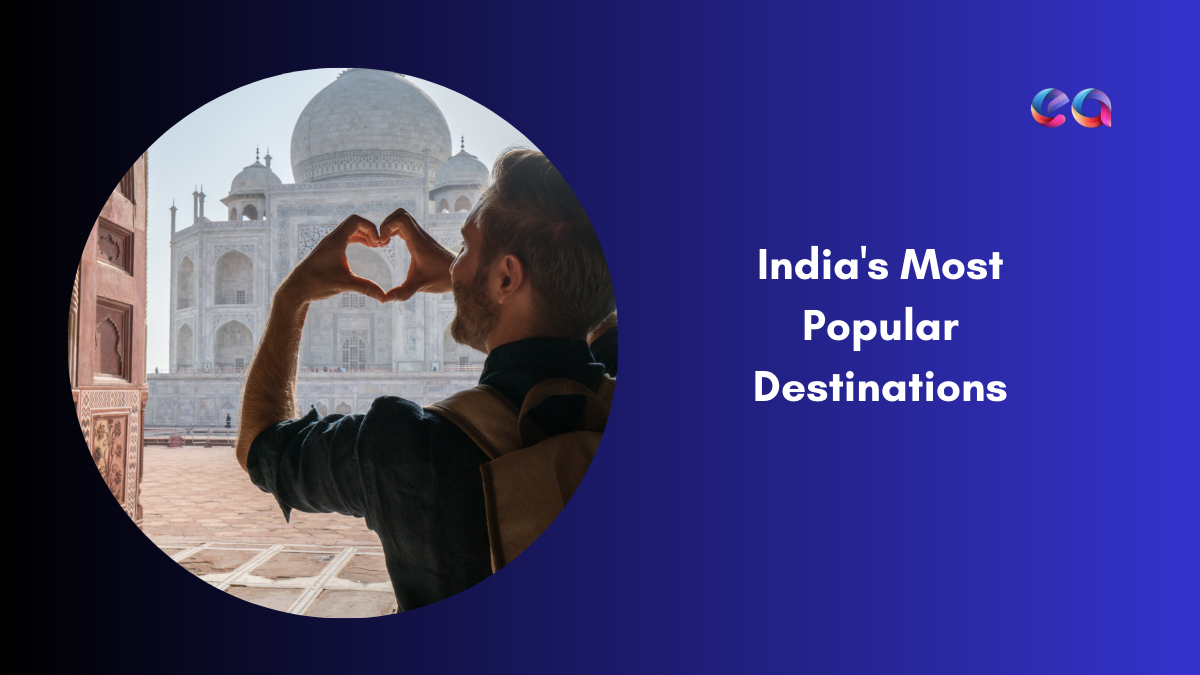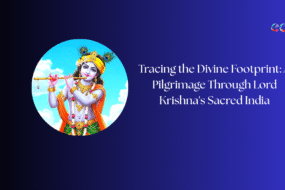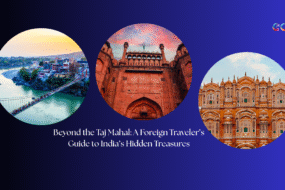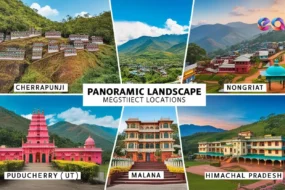
India, a land of remarkable diversity, captivates travelers with its rich culture, ancient history, and breathtaking landscapes. Stretching from the snow-capped peaks of the Himalayas in the north to the tropical beaches of the south, India offers something for everyone. The country’s vibrant festivals, diverse cuisines, and awe-inspiring monuments have made it a growing hotspot for tourists from all over the world. According to India’s Ministry of Tourism, over 10 million foreign tourists visited the country in recent years, with numbers steadily rising. Whether you’re seeking spiritual enlightenment, thrilling adventures, or simply a relaxing getaway, India is a treasure trove of experiences waiting to be explored.
Key factors attracting visitors to India include the deep-rooted traditions, architectural marvels like the Taj Mahal, exotic wildlife, and a wide range of activities that cater to both history enthusiasts and adrenaline seekers. Let’s take you on a journey through India’s most popular destinations, divided into distinct regions, each with its unique charm and attractions.
Table of Contents
The Golden Triangle
Delhi
The capital city of India, Delhi, is often the starting point for travelers embarking on the Golden Triangle tour, which includes Delhi, Agra, and Jaipur. This iconic triangle of cities offers a perfect blend of history, culture, and modernity.
- Historical Monuments: Delhi boasts some of India’s most magnificent historical landmarks. The Red Fort, a UNESCO World Heritage Site, is an architectural masterpiece that was the main residence of the Mughal emperors for over 200 years. Another must-visit is Qutub Minar, an ancient minaret that towers over the city as the world’s tallest brick minaret. Its intricate carvings and Islamic architecture make it a prime attraction.
- Cultural Experiences: No visit to Delhi is complete without a trip to Chandni Chowk, the heart of Old Delhi, where narrow lanes brim with the aroma of street food and bustling markets. Nearby, the Jama Masjid, one of the largest mosques in India, stands as a symbol of Delhi’s Islamic heritage.
- Modern Attractions: Moving to New Delhi, travelers can explore the India Gate, a war memorial that commemorates Indian soldiers who died during World War I. The Lotus Temple, with its stunning lotus-shaped architecture, is a Bahá’í House of Worship that welcomes people from all religions for meditation and peace.
Agra
Home to the world-famous Taj Mahal, Agra draws millions of tourists annually. This white marble mausoleum, a UNESCO World Heritage Site, is a symbol of love built by Emperor Shah Jahan in memory of his wife Mumtaz Mahal.
- The Taj Mahal: Visiting the Taj Mahal at sunrise or sunset is an unforgettable experience. The changing hues of the marble, bathed in the soft glow of the sun, add to the monument’s ethereal beauty.
- Agra Fort: Another significant attraction in Agra is the Agra Fort, a red sandstone fortress that was once the seat of the Mughal Empire. Its grand palaces, mosques, and courtyards provide a glimpse into Mughal life.
Jaipur
Known as the Pink City, Jaipur is a city of royal heritage and vibrant culture. With its pink-colored buildings and majestic forts, it offers visitors a peek into India’s regal past.
- Amber Fort: Overlooking the city from a hilltop, the Amber Fort is a stunning example of Rajput architecture. Its blend of Hindu and Mughal styles, along with beautiful mirror work inside the Sheesh Mahal, is a must-see.
- Hawa Mahal: The Hawa Mahal, or Palace of Winds, is another architectural gem. This five-story building with a honeycomb façade was designed to allow royal women to observe street festivals without being seen.
The South Indian Charm
While the north enchants with its historical grandeur, southern India is a paradise of lush greenery, beautiful beaches, and serene backwaters.
Kerala
Known as God’s Own Country, Kerala offers tranquil landscapes and is a top destination for those seeking relaxation.
- Backwaters: Kerala’s backwaters—a network of interconnected canals, rivers, and lakes—are best explored by houseboat. A cruise through these serene waters, surrounded by palm trees and traditional villages, offers a peaceful escape from the hustle and bustle of city life.
- Beaches: Kovalam and Varkala are two of Kerala’s most famous beaches. Kovalam is ideal for those looking for a luxurious beach vacation with upscale resorts, while Varkala offers dramatic cliffs and a more laid-back, spiritual atmosphere.
- Hill Stations: For a cool retreat, visit Kerala’s hill stations like Munnar and Wayanad. These scenic regions are known for their tea plantations, misty hills, and rich biodiversity.
Goa
Goa, India’s party capital, is famous for its beaches, nightlife, and Portuguese heritage.
- Beaches: The beaches of Anjuna, Baga, and Calangute are ideal for sunbathing, water sports, or simply relaxing with a cocktail. Each beach has its own vibe—Anjuna is known for its bohemian charm, while Baga and Calangute are bustling with tourists.
- Forts: Goa also offers a glimpse into its colonial past through its forts. Fort Aguada and Chapora Fort provide stunning views of the Arabian Sea and are perfect for history buffs.
- Nightlife and Water Sports: Goa’s vibrant nightlife is world-renowned, with beach shacks and clubs offering music, dance, and delicious seafood. Adventure seekers can indulge in water sports like parasailing, jet skiing, and scuba diving.
Tamil Nadu
Tamil Nadu is home to some of the most impressive temples in India, along with hill stations that provide a refreshing escape.
- Temples: Tamil Nadu’s temples are architectural wonders. The Meenakshi Amman Temple in Madurai, with its towering gopurams (gateway towers) covered in colorful carvings, is a spiritual and visual delight. The Brihadeeswarar Temple in Thanjavur is another UNESCO World Heritage Site known for its grandeur and historical significance.
- Hill Stations: For a break from the heat, visit Ooty and Kodaikanal, two charming hill stations nestled in the Western Ghats. These towns offer cool weather, picturesque views, and opportunities for trekking and boat rides.
The Northern Adventures
Northern India, with its vast deserts, majestic mountains, and royal palaces, is perfect for those looking for adventure and grandeur.
Rajasthan
Rajasthan is the land of kings, known for its opulent forts, palaces, and deserts.
- Forts and Palaces: Visit the City Palace in Udaipur, often called the Venice of the East, for its stunning lakes and royal architecture. Jodhpur’s Mehrangarh Fort and Jaisalmer’s Golden Fort are other must-visit attractions that offer insight into Rajasthan’s regal past.
- Desert Safaris: In Jaisalmer, you can embark on a desert safari in the Thar Desert, complete with camel rides, cultural performances, and stargazing under the desert sky.
Himachal Pradesh
Himachal Pradesh is a haven for nature lovers and adventure enthusiasts alike.
- Hill Stations: The picturesque hill stations of Shimla and Manali are perfect for leisurely vacations. With snow-clad mountains, charming colonial architecture, and lush green valleys, these towns are popular destinations for honeymooners and families.
- Trekking and Adventure Sports: For those seeking a thrill, Himachal Pradesh offers ample opportunities for trekking, paragliding, river rafting, and skiing.
Uttarakhand
Uttarakhand, known as the “Land of the Gods,” is home to sacred pilgrimage sites and scenic hill stations.
- Pilgrimage Sites: Haridwar and Rishikesh are two of the most important pilgrimage destinations in India, situated along the holy Ganges River. Haridwar is famous for its Ganga Aarti, a ritualistic prayer ceremony, while Rishikesh is the gateway to the Himalayas and a popular spot for yoga and meditation retreats.
- Hill Stations: For a serene mountain retreat, head to Mussoorie and Nainital, both offering panoramic views, peaceful lakes, and a relaxing atmosphere.
The Spiritual Journey
India is a land of spirituality, and several destinations offer travelers a chance to connect with their inner selves.
Varanasi
One of the oldest cities in the world, Varanasi is the spiritual heart of India. Pilgrims from all over the country come here to bathe in the sacred Ganges River and perform rituals at the ghats.
- Ghats and Temples: The Ghats of Varanasi, particularly the Dashashwamedh Ghat, are where the famous Ganga Aarti is performed every evening. Witnessing this ceremony is a profound spiritual experience.
Bodh Gaya
For those interested in Buddhism, Bodh Gaya is a must-visit. It is the place where Lord Buddha attained enlightenment under the Bodhi tree.
- Mahabodhi Temple Complex: A UNESCO World Heritage Site, the Mahabodhi Temple is a serene and sacred place of pilgrimage for Buddhists around the world.
Rishikesh
Known as the Yoga Capital of the World, Rishikesh attracts visitors for both its spiritual and adventure offerings.
- Yoga and Meditation Retreats: The peaceful environment, coupled with the presence of numerous ashrams, makes Rishikesh the ideal place to practice yoga and meditation.
- River Rafting: For adrenaline junkies, Rishikesh offers thrilling river rafting on the Ganges, which combines natural beauty with a rush of excitement.
Tips for Traveling in India
Traveling through India can be an incredibly rewarding experience, but it’s essential to be well-prepared. Here are some tips to make your journey smoother:
- Visa: Depending on your nationality, you may need to apply for a visa in advance. India offers e-Visas for tourists from many countries, making the process easier.
- Best Time to Visit: India’s weather varies significantly from region to region. The best time to visit northern India (Delhi, Agra, Rajasthan) is from October to March, while southern India is best visited from November to February. Monsoons (June to September) bring heavy rainfall, particularly to Kerala and Goa, making them less ideal during this time.
- Transportation: India has an extensive transportation network. Domestic flights are quick and convenient, while trains offer an affordable and scenic way to travel between cities. Buses and taxis are available for shorter journeys.
- Accommodation: India caters to all budgets, offering everything from backpacker hostels to luxury hotels. Be sure to book accommodations in advance, especially during peak tourist season.
- Food: Indian cuisine is as diverse as the country itself. From spicy curries to flavorful street food, there’s something for every palate. Be cautious with street food and stick to bottled water to avoid stomach issues.
- Culture and Etiquette: India’s customs and traditions are deeply rooted in its culture. Respect local practices, such as removing shoes before entering temples, dressing modestly, and avoiding public displays of affection.
Conclusion
India’s diverse landscapes, rich history, and cultural vibrancy make it one of the most fascinating destinations in the world. From the royal forts of Rajasthan to the serene backwaters of Kerala, the spiritual ghats of Varanasi to the bustling streets of Delhi, India promises a unique and unforgettable experience. Whether you’re an adventure enthusiast, a history buff, or someone seeking spiritual solace, India has something for everyone.
Start planning your Indian adventure today and immerse yourself in the beauty and diversity of this incredible country. The journey through India’s most popular destinations is sure to leave you with memories that last a lifetime.













